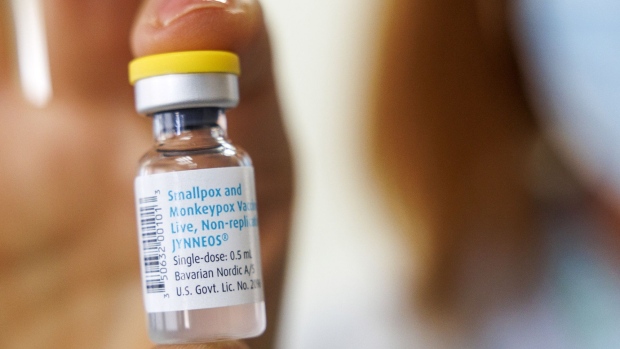Sep 28, 2022
Monkeypox Outbreak Slows in US, Shifting Focus to Prevention
, Bloomberg News

(Bloomberg) -- US monkeypox cases are declining nationally, driven by a growing vaccine supply and community-based outreach, marking a hopeful sign for an outbreak that’s afflicted more than 25,000 Americans.
Since the outbreak peaked in August, daily case rates have been dropping, data show, with just 66 new infections reported on Sept. 21. In cities where monkeypox cases exploded early on, such as New York City, cases have declined sharply, and in San Francisco case rates have also slowed down, health officials said at a briefing Wednesday.
But even with signs that the US outbreak could be turning a corner, officials are focused on ensuring people get vaccinated, which includes emphasizing the importance of returning for a second shot. The US is also shifting to a pre-exposure strategy and letting people get shots in a less-visible place than the forearm.
“This new PrEP strategy means that more people who might be at present or future risk for monkeypox now qualify for the vaccine,” said Demetre Daskalakis, the White House’s deputy monkeypox response coordinator.
Data from the Centers for Disease Control and Prevention have shown significant overlap between sexually transmitted infections, HIV infections and monkeypox cases, which has pushed health officials to focus more resources on this population going forward. Sixty-one percent of monkeypox patients also had either an STI or HIV, according to the data.
Daskalakis said that monkeypox isn’t a virus that “lives in isolation,” and that the people who should be vaccinated are largely the same people who need to be getting screened for HIV and STIs.
Read more: Monkeypox is spreading through sex, but isn’t an STI
Though monkeypox isn’t considered a traditional STI, the virus has been spreading in much the same way. One CDC report from August found that in 94% of monkeypox cases, patients reported recent male-to-male sexual contact. It can also spread through other forms of close contact.
However, the Covid-19 pandemic has led to increasing STI rates, with more new cases of syphilis, gonorrhea and chlamydia in 2021, according to preliminary data from the CDC. Funding for sexual health clinics in the US is scant, and the pandemic posed a challenge for STI screening visits.
“If one were to think that a patient is presenting with monkeypox, that should all of a sudden trigger screening for other STIs including HIV, gonorrhea, chlamydia, syphilis and others,” CDC Director Rochelle Walensky said at the briefing. “We are really hoping to capitalize on this moment for awareness not just about monkeypox, but other STIs as well.”
With the Biden administration’s requests for Covid-19 and monkeypox funding stalled in Congress, US health officials are using federal dollars meant for STIs and HIV to fight monkeypox. Walensky said they’re looking to “braid these resources together” to fight monkeypox and the ongoing STI epidemic.
With so much of the US strategy hinging on Bavarian Nordic A/S’s monkeypox vaccine, called Jynneos, government researchers have also been collecting data on how effective the shot is. Health officials said Wednesday that early lab-based results showed a single dose provided up to 14 times more protection to at-risk people.
However, the data don’t yet account for the lower-dose strategy the US switched to in order to stretch vaccine supplies in early August. Studies are ongoing to fully understand how much protection is offered by the vaccine, health officials said.
©2022 Bloomberg L.P.


